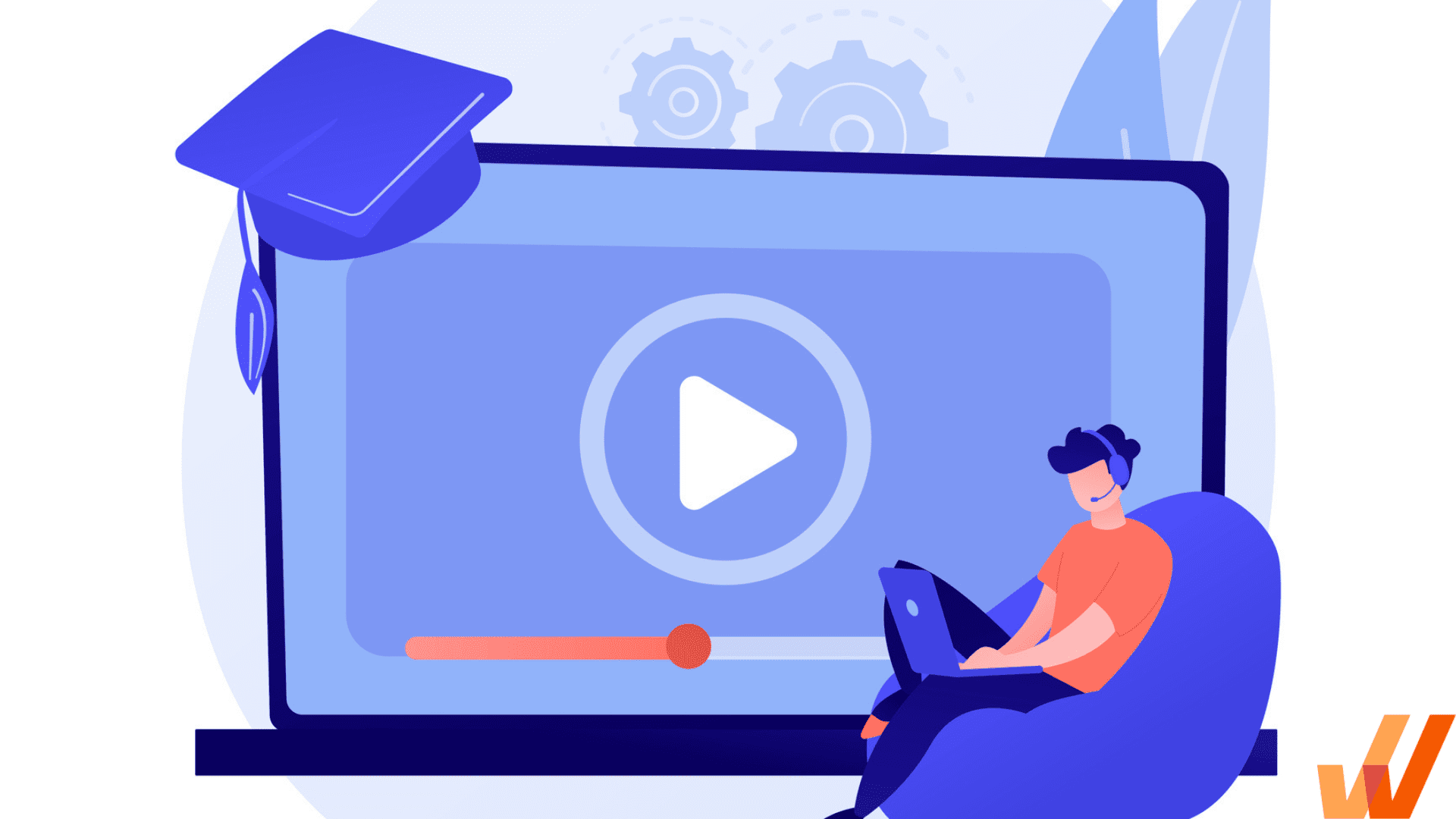What Is Microlearning? Examples, Benefits, Best Practices
- Published: October 24, 2022
- Updated: February 27, 2024


Today, organizations are focused on creating an engaging and practical learner-centric experience for their employee learning. This requires a well-planned L&D strategy aligned with business goals and outcomes. It also requires the correct type of learning content with contextual substance and digestible formatting.
Considering the fast-paced professional world and the reduced attention spans of the digital workforce, traditional long-form training programs that occur annually or semi-annually are not enough for employees to keep up with industry standards.
To enable employees to achieve their professional and personal goals while also managing their daily production, many organizations are implementing microlearning – a type of employee training that teaches employees in subtle, short-timed bursts that over time help team members develop new skills and retain more knowledge.
In this article, we’ll define microlearning, explore benefits and challenges of microlearning, highlight a few enterprise examples of microlearning to draw inspiration from, share best practices and tips for building your microlearning strategy, and more.
What Is Microlearning?
Microlearning is an approach to learning new knowledge that breaks learning content down into small, bite-sized information modules. Smaller learning sessions provide all information necessary for learners to achieve a specific training objective in a short window of time, making microlearning valuable in business contexts.
Microlearning is effective because learners apply the skills they’ve acquired before they lose attention, thus improving knowledge retention. This is also referred to as real-time learning.
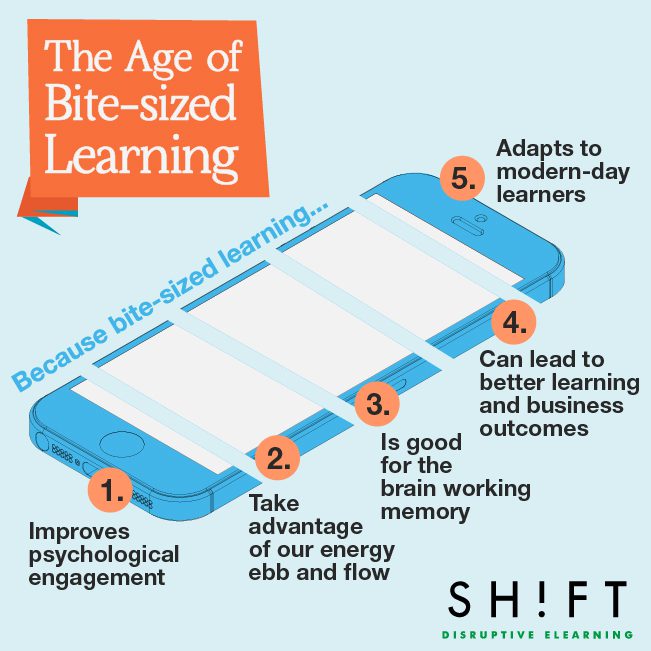
The History of the Microlearning Theory
The idea of microlearning is built on forgetting curve theory created by Hermann Ebbinghaus. First created in 1880s, his concept and ideas built a scientific approach to understanding knowledge retention and optimizing the learning curve.
In his studies, Ebbinghaus discovered that learning retention changes over time, with the ability to retain knowledge increasing and decreasing throughout his trial. He also noted that the subject matter, the learners’ relation to the subject matter, and the learning style all played a role in retention.
A key finding was that people on average lost 50% of new knowledge within an hour and 80% of new knowledge they’ve learned within a month.
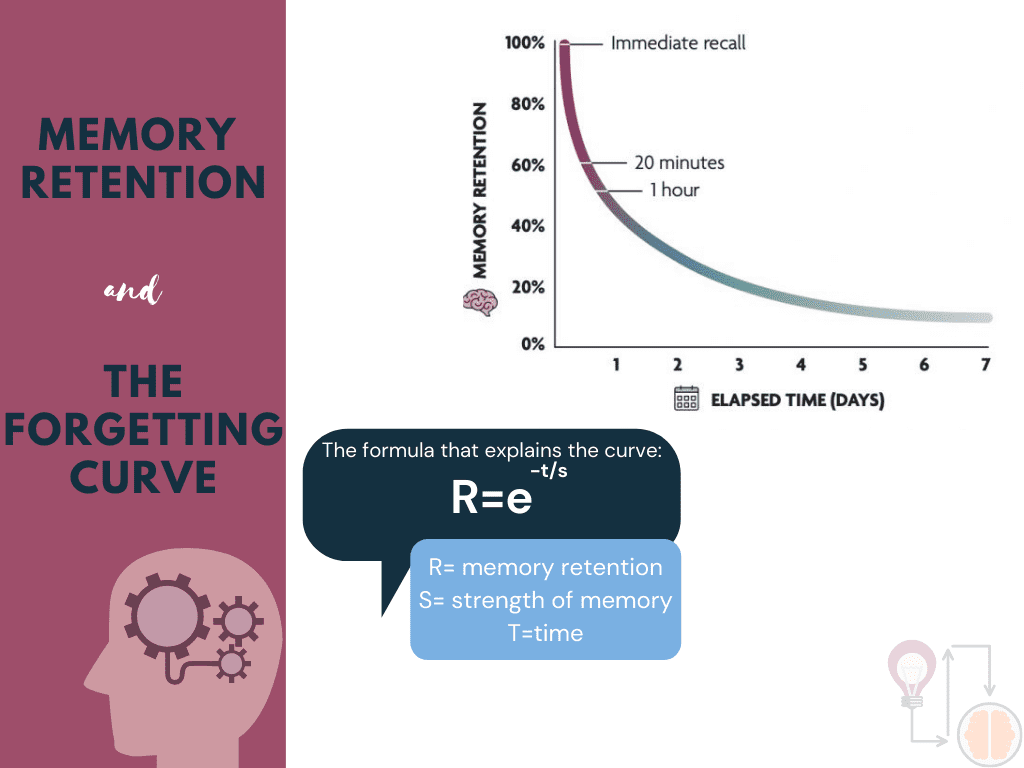
He found that while people retain a portion of new information for a certain amount of time, that knowledge decays overtime if it’s not considered necessary by the learner or is not contextually designed for them.
By implementing a microlearning framework, enterprises can break learning content and concepts into small pieces, present them at the right time in the flow of work, and reaffirm those concepts over time to drive knowledge retention and improve overall productivity.
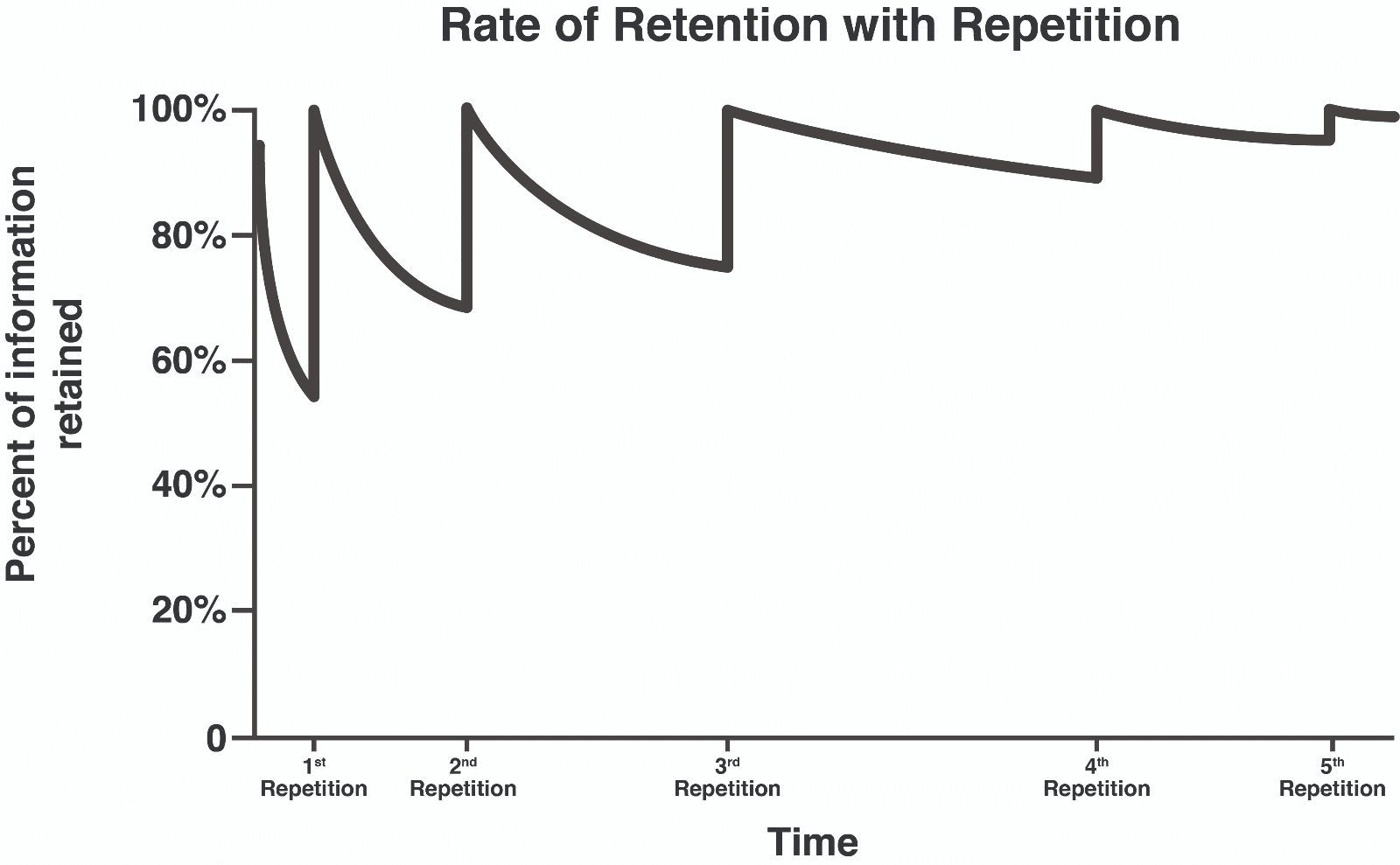
By providing these microlearning concepts in the workplace through gentle nudges and reminders, moment-of-need support, and learning in the flow of work with in-app guidance, learning retention rates can spike.
Traditional forms of learning and employee training have a 10-20% retention rate after 3 days, while learning while doing has a retention rate of 92%. This helps create a more effective on-the-job training environment through more contextual information presented to employees in their daily workflows.
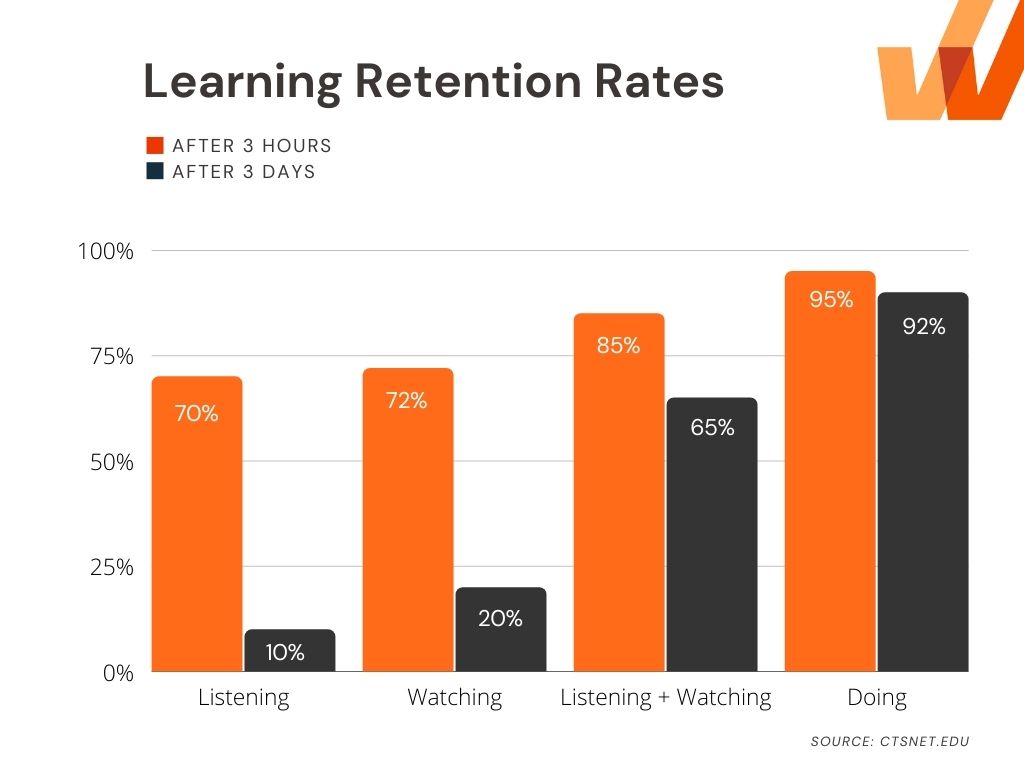
Benefits of Microlearning
Here are a few of the biggest advantages of implementing a microlearning strategy at your organization.
1. Learner-centric
Microlearning enables learners to choose precisely what they want to learn whenever they want to. Microlearning can be embedded directly into a learner’s flow, reducing friction and helping to apply newly learned knowledge instantaneously.
Overall, microlearning makes training content personalized and easily digestible, simplifying the learning process and making it flexible for learners.
2. Just-in-time & accessible
The bite-sized nuggets are accessible to learners at all times and can be pulled on demand. This moment-of-need training style helps people learn on the fly, and in a relevant situation that provides context and nuance to the material.
Additionally, making microlearning content mobile-friendly also enables remote training, which is convenient for employees.
3. Less time consuming
Microlearning incorporates short-length courses that are easy to read and comprehend. The design formats include rich media such as videos and infographics, leading to better knowledge retention. This allows learners to grasp important concepts quickly and not lose productivity while learning new skills.
4. Higher employee engagement
With employees already bogged down with multiple tasks in their daily routine, keeping them engaged with learning for a long time can be challenging. With microlearning, employees get concise and engaging content that can be learned quickly while working on their daily tasks.
5. Higher knowledge retention
Delivering training in small segments enables learners to focus on one concept at a time instead of overwhelming them with a lot of information, thereby promoting higher learning retention.
6. Affordable and agile
Due to the short training duration, the microlearning costs are lower than traditional eLearning. They can be created and deployed rapidly, much quicker than traditional eLearning.
7. Shorter development cycle
Typically, all the formats of microlearning, whether a performance support tool or an instructional video, have a much shorter development cycle. Also, small-length courses are easy to update and upgrade.
8. Wider application
Microlearning formats can be used to train a new employee from scratch or can also serve as a refresher for an experienced employee. You can also use these nuggets as stand-alone assets or they could be part of a series of microlearning courses.
Challenges of Microlearning
While there are numerous benefits of microlearning, it doesn’t come without its challenges. Let’s discuss some of the major challenges of microlearning.
1. Managing vast amounts of content
Unlike other eLearning formats where content is split into 30 or 60-minute sessions, microlearning content may only be 5 -10 minutes long, so you’ll need to create more content to cover all topics. Creating, organizing, and maintaining so much content within your LMS can be time-consuming.
2. Creating balanced content
Making your content short and engaging while keeping it detailed and informative can be challenging. Subject matter experts must carefully curate the content to make it impactful and include all the key information learners need on each microlearning topic.
3. Scaling personalized content
Because microlearning courses are concise, they could result in hundreds of different modules for one training course. Going through all this information, personalizing it, and directing it to the right individuals can be an extremely tedious task.
6 Microlearning Examples to Use as Inspiration in 2022
There are a number of microlearning examples across billion-dollar enterprises like Google, IBM, and Cisco, to name a few. Here are six corporate microlearning examples to use as inspiration for your L&D team:
1. Google's Whisper Courses for Manager Training
In the first of our microlearning examples, let’s start with Google’s simple yet effective take on the training approach. When their managers had to be trained on the importance of safe team culture, Google looked for an effective employee training method that went beyond traditional classroom training.
Google’s Challenge
A training session or a seminar is meaningless if learners can’t apply what they are taught in real-life situations. This is precisely the challenge that Google wanted to address. They needed a training method that would help managers retain important information and also prompt them to practice what they knew.
Google’s Solution
Google implemented microlearning through what they called a ‘whisper course’. It consists of a series of emails each of which contained a suggestion that managers could try out during their team meetings.
Why the Solution Worked
The whisper courses are centered around the idea that you often need is a gentle nudge, a reminder to practice what you know. Each of the emails focuses on ‘the what, why, and how’ of the learning objective and is followed by a simple CTA or an experiment.
Below you can see an example of one such email:
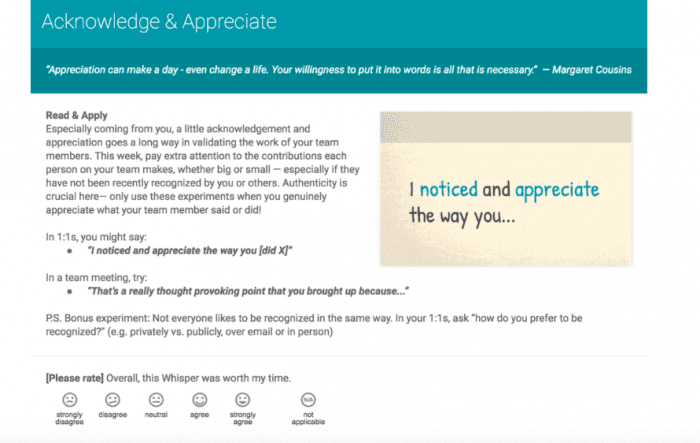
Instead of overwhelming employees with an overload of theoretical information, breaking it down into small, easily executable tasks makes the information easy to retain and easier to apply.
2. Cardinal Health Using a Digital Adoption Platform to Improve Its Salesforce Adoption
Among the microlearning examples we have taken here, Cardinal Health’s approach is particularly interesting. The employees at the Fortune 14 company were facing a roadblock in adopting Salesforce and they needed an effective solution.
Cardinal Health’s Challenge
Cardinal Health, Canada was facing a significant challenge in the adoption of their Salesforce CRM due to a number of reasons –
- The sales reps were mobile workers and were finding it quite difficult to take out time for training. The nature of work made it logistically hard to arrange classroom training sessions that the sales reps could benefit from.
- Support teams were receiving repetitive queries even after the training sessions, which indicated a gap in knowledge retention. A lot of time and effort that could be invested in solving more complex queries was being spent in answering simple, repetitive queries.
- The Salesforce training sessions focused more on why it was important for sales reps to use Salesforce rather than showing them how to use the application. With sessions being more theoretical than practical, the sales reps were not able to use the Salesforce application to its full potential.
Cardinal Health’s Solution
Cardinal Health approached Whatfix, a Digital Adoption Platform to improve their Salesforce adoption by providing their sales reps with a better form of training. Employees were subjected to a real-time learning environment through learning by doing with Digital Adoption. Using Whatfix’s core technology, interactive walkthroughs, sales reps were provided task-based learning that allowed for shorter and more effective training.
Why the Solution Worked
With training and user assistance available on-demand, sales reps could better engage with Salesforce. The task-based nature of the Whatfix platform was able to solve a number of queries that sales reps had on a consistent basis. They could learn to use the application at their own pace without setting aside time exclusively for training. This actually made the sales reps more open to learning than they were with classroom training sessions.

Above you can see how Whatfix seamlessly offers Digital Adoption within the Salesforce platform. Sales reps can access all the information they need without having to disrupt their workflow.
3. IBM Using Microlearning to Develop Cloud Expertise
IT professionals and web developers using the IBM Cloud platform often had a number of ‘how-to’ questions that cropped up as they were using the platform. Through microlearning, IBM found a better way to answer these questions.
IBM’s Challenge
Employees working with IBM Cloud often need to develop some key skills each time they handle a project. And they needed to develop these skills quickly. They could not wait for scheduled training classes and practice labs every time they had a project or an assignment.
IBM’s Solution
In 2018, IBM launched IBM Microlearning, a platform that helped employees to develop cloud expertise at their own pace. The platform consisted of a number of exercises, each of which answered a specific question and helped employees develop a specific skill.
Why the Solution Worked
The IBM microlearning platform offered employees a quick, focused, and easily accessible way to develop the skills they require. Employees can access the platform at any time during their day and work their learning according to their own pace. The short-spaced lessons do not overwhelm employees with information, rather, it helps them develop their knowledge quickly and efficiently.
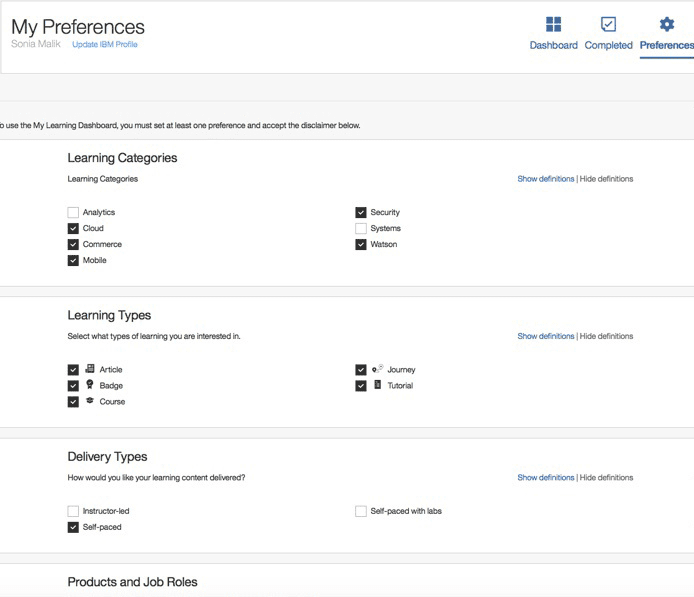
4. Cisco Using Bite-Sized Videos to Answer IT Questions
Next in our list of microlearning examples is Cisco’s approach to answering information technology questions.
Cisco holds the Cisco Career Certification Program to ensure that IT professionals are equipped with the skills and knowledge required to work on Cisco products. The enterprise uses microlearning to help learners work their way through the information required to complete the Cisco certification exams.
Cisco’s Challenge
Employees taking the Cisco certification exams found it tedious to go through all the course material before the exams. Not to mention, the vastness of the material meant employees were more than likely to forget significant chunks of what they have learned and not retain that knowledge.
Cisco’s Solution
Cisco has a repository of resources dedicated to learners taking the Cisco certifications called the ‘Cisco Learning Network’. The network consists of a series of short, 6-7 minute learning videos called ‘Cisco Answers IT’. Each of these videos includes excerpts of longer IT training videos and deal with specific concepts. They act as a quick refresher of the most common IT topics.
Why the Solution Worked
Cisco’s microlearning video series gives learners a quick recap of all the important concepts. Instead of spending hours going through long and endless training videos, learners can simply pull up one of these videos to refresh a concept in no time. The content within the videos is just long enough to span the learner’s attention and short enough so that the learner does not lose interest. The videos are also used by other employees as a reminder of important concepts before they start their work.
In the image below, you can see how each of the videos in the series deal with only one topic. Also note that each of the videos is no longer than 6 minutes.
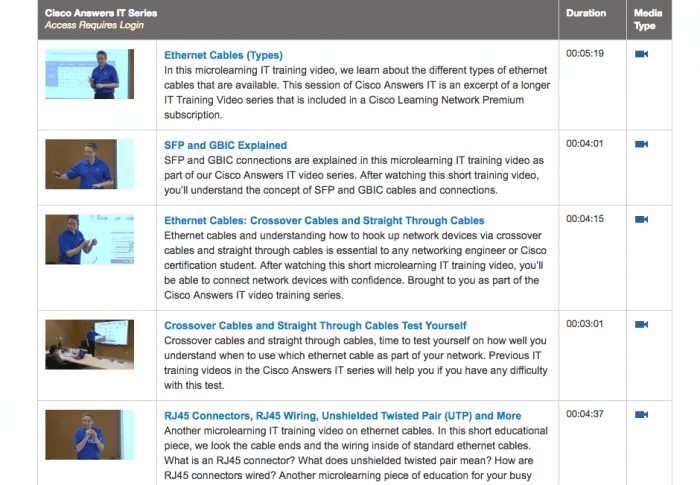
5. ADP Using 3-Minute Lessons for Client Training
The next in our list of microlearning examples is ADP. The enterprise has a vast range of human capital management (or HCM) products that are being offered in over 130 countries and over 610,000 clients. The HCM software company is responsible for training this huge client base. They needed a training approach that could be designed to suit individual learners.
ADP’s Challenge
At ADP, frequent training is important, considering the sheer number of products and an equally large number of clients. The fast-paced nature of business demands needed a training approach that could quickly and effectively enable personalized learning.
ADP’s Solution
ADP adopted microlearning as their training approach and created the Learning Bytes platform for effective client training. The platform consists of a combination of job aids (or PDFs) and videos which can be consumed in less than 5 minutes.
Each application is divided into a number of lessons and each lesson is demonstrated using a narrative video or job aids. All the training demonstrations are made available on the platform to easily access whenever required. Each lesson contains highly precise information and breaks down complex instructions into 7- 10 short, executable steps.
Why the Solution Worked
Within a few months of launching the platform, ADP noted a large number of logins and course completions. Also, their total training time went straight down from 24 hours to 7 hours.
The reason the platform proved to be such a success is because of how focused each of the lessons in the platform was. Clients need not focus on the different applications at once. The job aids and videos are highly task-based. It helps the clients understand, in quick detail, how to execute the different aspects of an application and builds their knowledge as they progress.
Here is how the Learning Bytes looks to a learner. You can see that a single application has been broken down into several lessons each of which contains information in the form of a video or a job aid or both.
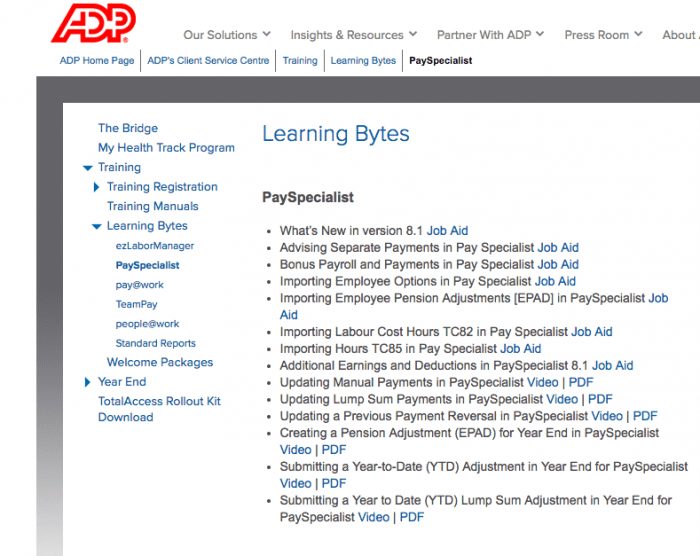
6. Unilever Using "Snackable" Learning for Employee Training
The next microlearning example offers insight into how Unilever trains employees using easily consumable content. The company wanted to establish a sense of ownership among its employees which required them to undergo regular training.
Unilever CHRO, Leena Nairuses microlearning or “snackable” learning as Nair calls it, to provide constant training to their employees.
Unilever’s Challenge
Unilever realized that despite the need for regular employee training, it was impractical to expect employees to dedicate a day or two towards such training. They also saw that most of the training material tended to be daunting and could distract employees even before they started learning. The company needed a training approach that could deliver learning in short bursts and was personalized to meet employees at the moment of their need.
Unilever’s Solution
They developed a microlearning tool to offer regular training to their employees called the “My Learning Platform.” It consists of a number of modules that combine TED talks, instructional videos, social campaigns, and other resources that can help employees learn and grow in their careers. All the available material is simplified and personalized to help employees learn with ease.
Why the Solution Worked
Through microlearning, Unilever managed to make training content more approachable. Information was now more personalized and easily consumable. Employees are able to access these training resources at any given time during their workday and all they have to do is spend 15 minutes each day to learn a new skill.
As training becomes flexible with microlearning, employees begin to show increased interest and active participation in the learning process. More importantly, the platform offers learning material that is not just limited to what they do at work. Instead, employees are encouraged to explore topics of their interest as well, making learning personalized to suit individual interests.
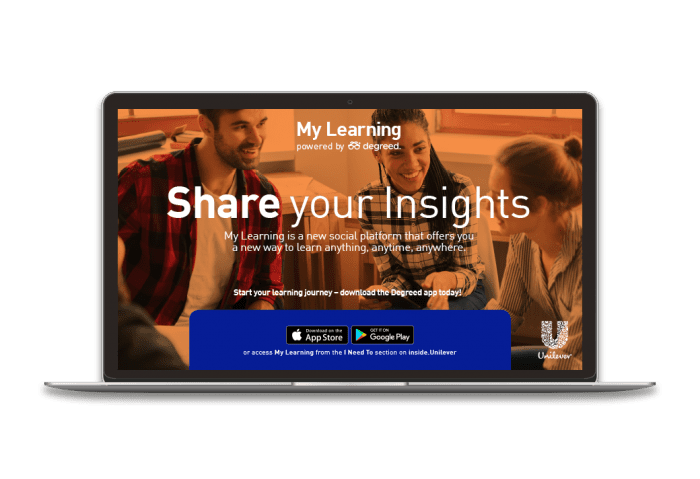
4 Ways to Leverage Microlearning for Effective Employee Training
Let’s discuss different ways to leverage microlearning for effective employee training.
1. Performance support tools
With the help of a performance support tool, learners can obtain knowledge and implement it simultaneously. The information to be conveyed is broken down into small fragments and presented in a step-by-step manner, one instruction at a time. These tools integrate microlearning with ‘learning-by-doing’ approach.
Let’s get into the nitty gritty of performance support tools with the example of Whatfix. Whatfix is a digital adoption platform that helps implement effective software training for your employees. Besides dividing the course content into small chunks to enable microlearning, Whatfix also makes learning interactive. This is accomplished with the help of in-app interactive walkthroughs that guide employees through complex digital processes. You can also embed a self-help center directly into the application or software for employees to search for contextual answers to their queries.

2. Instructional videos
According to Forrester, “employees are 75 percent more likely to watch a video than to read documents, emails or web articles”.
Training videos can be integrated directly into your site or shared privately on a video hosting platform (such as YouTube) to deliver to remote employees. Employees can access training videos whenever they want and take their time to absorb the information offered. Shorter instructional videos help ensure that employees stay engaged throughout the lesson and can apply their knowledge immediately.
CRM Learning provides videos that organizations use to provide employees with effective online and classroom training. These learning videos can be streamed from CRM learning’s proprietary LMS or your organization’s own LMS.
3. Lesson-based podcasts/webcasts
Podcasts personalize training by creating a conversational framework that improves effectiveness and retention. It allows employees to access training at different times depending on their workload and availability.
Podcasts deliver content through small learning steps supported by small chunks of content and easily digestible information. Podcasts are specifically helpful for auditory learners, i.e., people who learn best through listening. Most training methods are designed for visual learners because they constitute the majority (60%).
Research done by Sultan Qaboos University, Oman studied the effect of including podcasts as a microlearning tool. The before and effect of its usage is depicted in the graph below.
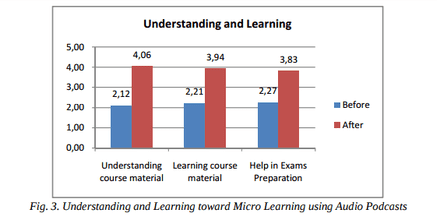
Podcasting has also become much easier to create for non-technical L&D team members – from recording, editing, publishing, and hosting.
Many free and paid podcasting editing tools, ranging from beginner stools like Audacity’s free tool to expert-level editors like subscription Adobe Audition tool, are available to L&D teams building microlearning audio clips. For hosting your podcasts, LibSyn (Liberated Syndication) is one of the largest platforms. It has a striking feature set that offers the option of turning your podcasts into a mobile app. You can also use SoundCloud or YouTube to publish, host, and organize your podcast-related content.
4. Training simulations
Training simulations present users with a game-like atmosphere. The application includes images and graphics, voice, background music, and special effects in a virtual environment. In a live setting, scenarios are recreated to resemble real-life situations.
Typically, if users don’t select the best solution, they are remediated until they do so. With practice, learners identify suitable solutions to practical issues and later incorporate these solutions into their daily activities. In some simulations, learners receive points for each decision they make, helping them understand the effectiveness of their decisions.
Training simulations have gained popularity as a microlearning tool because users can start and end the simulation on their own time and finish it without any external help.
Designers from Designing Digitally create simulated learning experiences for employee training. These simulated learning experiences range from a complete 2D simulated software experience up to a 3D immersive experience.
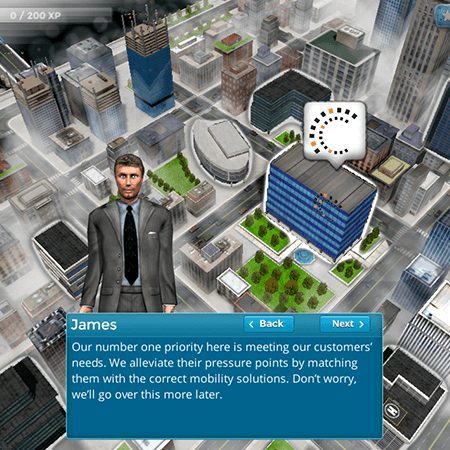
Microlearning Best Practices
Here are a few best practices to remember when creating a microlearning strategy.
- Use gamification techniques to turn your microlearning courses into a ‘game’ per-se. It gives your employees a feeling of achievement and satisfaction on completing a goal.
- Enhance your microlearning modules by including attention grabbing elements like videos and quizzes.
- To boost knowledge retention, include a short review or quiz at the end of a series of microlearning modules for employees to review what they’ve learned.
- Create microlearning materials that can be accessed via any device, especially on smartphones and tablets.
- Use videos of experts answering specific questions, PDF downloads, infographics, digital guides, interactive diagnostics and more.
5 Best Microlearning Platforms in 2023
To enable effective learning in your organization, here’s a list of the top five microlearning platforms available in the market.
1. Whatfix
Whatfix is a digital adoption platform that helps implement effective software training for your employees. Besides dividing the course content into small chunks to enable microlearning, Whatfix makes learning interactive via in-app interactive walkthroughs that guide employees through complex digital processes.
You can also embed a self-help center directly into the application or software for employees to search for contextual answers to their queries. Furthermore, Whatfix has integration capabilities with all popular LMS platforms, and is xAPI and SCORM compliant.

G2 Review Rating: 4.6/5
Price: Get a quote
2. Edapp
EdApp is a free microlearning platform with an integrated authoring tool. It is loaded with features such as spaced repetition, gamification, rewards, and analytics. These features make learning fun and engaging, thereby improving knowledge retention. Edapp also enables mobile learning that brings benefits such as push notifications for lesson reminders, cloud distribution, and translation, plus the ability to deliver microlessons directly to learners’ pockets.
G2 Review Rating: 4.8/5
Price: $0.00 – $2.95/month
3. iSpring Learn
iSpring Learn allows starting a microlearning program and tracking results without fine-tuning complex settings, or involving IT staff. You can create training material from your existing content, such as videos, slides, or articles. The platform has a built-in authoring tool that can be used to create responsive microlearning courses with knowledge checks that work efficiently on smartphones and desktop.
G2 Review Rating: 4.6/5
Price: $2.82 – $3.66/user
4. Talent Cards
Talentcards is a mobile training platform that utilizes a flashcard approach which qualifies as bite-sized learning modules. The tool helps create microlearning courses in just three steps:
Create card sets with your training material
Add users to the platform and invite them to download the app
Share your card sets for everyone to access on their smartphones
G2 Review Rating: 4.8/5
Price: $0.00-$75.00/month
5. OttoLearn
OttoLearn provides gamified microlearning for increasing knowledge retention and improving employee performance. You can easily design micro-lessons that fit into your employees’ workday, minimizing disruptions and allowing learners to control how, when, and where they learn. OttoLearn also allows you to measure where the knowledge gaps are so that you can develop proccesses to cover them immediately.
Price: Starting from $500/month
In today’s fast-paced digital environment, where employees need to be continuously trained on the latest technologies, microlearning is becoming a leader in innovative learning strategies. Microlearning content fits into the hectic day-to-day routines of the employees more quickly than full-blown training courses.
If you are wondering how and where to begin, try implementing a digital adoption platform like Whatfix for your corporate training programs. Whatfix enables microlearning for your employees by providing them with short, focused, and engaging training content within the application itself. The information to be conveyed is broken down into small fragments presented via step-by-step interactive walkthroughs to enable effective training programs.
Schedule a free demo with us to learn more about creating byte-sized, personalized, on-demand corporate training programs supported by advanced analytics.
Request a demo to see how Whatfix empowers organizations to improve end-user adoption and provide on-demand customer support
